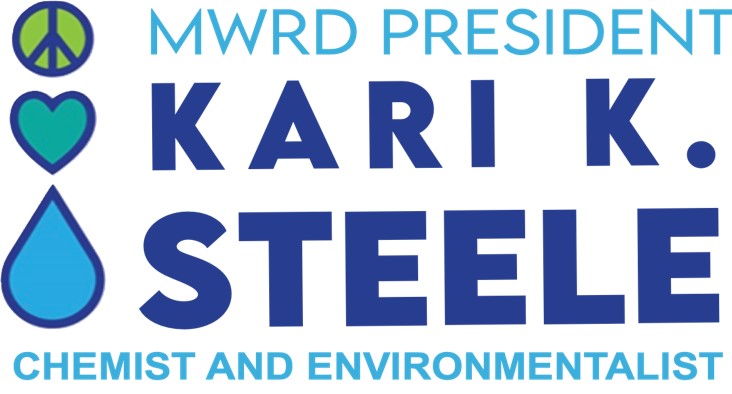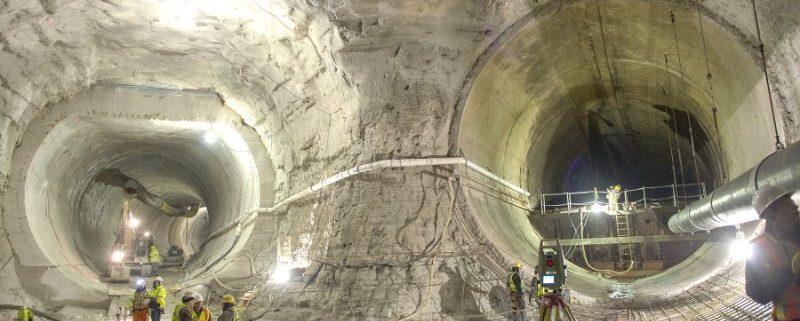McCook Reservoir Information
1. The history of TARP:
a. TARP stands for Tunnel and Reservoir Plan
b. Plan was adopted by MWRD Board of Commissioners in 1972 with the main goals of solving pollution and flooding problems within the 375 square mile service area that contains combined sewers.
c. Describe how combined sewers work:
i. installed in older communities and generally prior to wastewater treatment plants
ii. stormwater runoff is directed to the same sewers that convey sewage from homes and businesses in the service area. During dry weather it goes to a plant for treatment but during wet weather the plants reach capacity and overflow is diverted to waterways as a CSO.
iii. TARP is designed to capture that polluted water before it gets to the waterway and convey it to reservoirs to be stored until the plants have excess capacity to clean the water after a storm.
d. Construction of the Phase 1 tunnels, often referred to as deep tunnel, began in 1975 in Wilmette.
e. Tunnels were completed in 2006 and have been in operation since mid 80s, keeping polluted water out of area waterways and basements.
f. Tunnels can capture 2.3 billion gallons of polluted water. Reservoirs will increase this storage volume to 17.5 BG, approximately 7.5 times what we currently can hold in the tunnels alone.
2. How McCook Reservoir fits in:
a. Serves the Chicago area north of 87th Street and 36 suburban communities, a 252 square mile area with a population of approximately 3.1 million people.
b. Stage 1 is approximately 3.5 billion gallons and is scheduled to go online in late 2017. Stage 2 adds another 6.5 billion gallons, for a total of 10 billion gallons–the equivalent of 200 million rain barrels.
c. You can fit more than 11 Soldier Field Stadiums inside it, and is nearly deep enough to stack another 11 on top of that.
d. When complete, this will be the largest reservoir of this type in the world.
3. Work involved in making this a reservoir.
a. Mining the hole:
i. Agreement with Vulcan Construction Materials was reached in 2003, allowing them to create the rough hole we needed and sell the rock through their existing quarry
ii. McCook Reservoir site is a new quarry on District property, but is adjacent to Vulcan’s existing McCook Quarry, which is one of the largest aggregate quarries in the country.
iii. McCook Quarry has been in business for over 100 years and its strategic location adjacent to District property made this an ideal site for the District’s reservoir construction.
iv. Aggregate is used in all types of construction projects in the Chicagoland area such as road and building construction.
b. 73rd Street Tunnel Relocation
i. Because the original TARP plan had the McCook Reservoir in a different location, a portion of the Mainstream Tunnel had been constructed through the area which would ultimately become the reservoir.
ii. Approximately 7,000′ of tunnel was rerouted around the new reservoir footprint.
c. Overburden Removal
i. In order to expose the limestone that would be mined by Vulcan, the overburden (dirt) above the rock would have to be removed.
ii. Over 9.4 million cubic yards of overburden were removed from the site to expose the top of rock (most was disposed of in the existing quarry, but some was used to create a hill further southwest along the canal).
d. Grout Curtain and Slurry Wall Contracts:
i. Purpose is to seal the ground around the entire reservoir perimeter
ii. A double row grout curtain was installed around the outside perimeter of the hole. From the surface, holes were drilled into the rock over 300’ deep at a 15 degree angle and then filled in stages from the bottom up with grout under pressure. The grout migrates into all of the cracks and fissures in the rock mass to reduce the permeability. The holes are drilled approximately every 5 feet around the nearly 3 mile perimeter of the reservoir. A second row is then constructed about 15 feet away, angled in the opposite direction in an attempt to intercept and seal as many cracks as possible. A total of 373 miles of holes were drilled for the grout curtain.
3
iii. The grout curtain ties into a nearly impermeable natural layer of shale that exists approximately 325 feet below ground, preventing water from leaving through the bottom of the reservoir.
iv. A 14,450 foot long slurry wall was also installed around the outside perimeter of the reservoir, between the two rows of grout curtain holes, and is intended to seal the roughly 50 foot deep layer of overburden (dirt) above the rock.
v. To create the slurry wall, an approximately 3′ wide trench was dug in the overburden around the perimeter, and keyed into the rock, and was then filled with an impermeable bentonite slurry. As the reservoir is not intended to fill above the top of rock, the slurry wall functions primarily to keep ground water out of the reservoir.
e. Conveyance Tunnel
i. Purpose is to connect the reservoir site to the existing McCook Quarry to facilitate transporting the rock mined from the reservoir.
ii. A 2,000′ long tunnel was constructed in rock and contains a conveyor that is used to bring rock from the reservoir site, beneath I-55 Stevenson Expressway and the Des Plaines River to the existing quarry.
f. Addition of Pumps and Motors
i. Since the reservoir will add so much additional storage volume, it was necessary to add pumping capacity at the District’s Mainstream Pumping Station, which pumps the water approximately 4.5 miles, from the reservoir to our Stickney WRP for treatment.
ii. Two large pumps and motors, capable of pumping 330 cubic feet of water per second were added at Mainstream.
g. Distribution Tunnels
i. In order to dewater the reservoir to the Mainstream Pumping Station, a series of tunnels was required between the pumping station and the reservoir.
ii. A series of four tunnels were constructed which span from a new underground chamber to both the pump station and the reservoir.
iii. The chamber contains a series of gates and valves which assist in controlling the direction of flow in and out of the reservoir.
h. Main Tunnels and Gates
i. The Mainstream Tunnel connects to the reservoir via a new tunnel.
ii. A gate chamber was constructed at about the midpoint of the new tunnel which contains 6 large wheel gates (18’ wide by 31’ high by 3’ thick, each weighing 256 tons) used to control flow into the reservoir from the Mainstream Tunnel.
iii. The wheel gates were procured under a separate contract but are installed as a part of the Main Tunnel contract.
i. Slope Stabilization and Retaining Walls
i. In order to protect the overburden slope and to maximize the volume of the reservoir, it was necessary to build retaining walls and to stabilize the slopes above those walls.
ii. Various types of retaining walls, including gabion basket, soil nail, and concrete block, were built under a series of contracts.
iii. The slopes above the retaining walls were graded, covered with a plastic geo-grid, and filled with stone excavated from the reservoir site.
j. Rock Wall Stabilization
i. The reservoir rock walls were stabilized to prevent rock falls and maintain the near vertical highwalls.
ii. Stabilization techniques include rock dowels, chain link mesh, and shotcrete.
k. Final Reservoir Prep (Stage 1)
i. Final connections to the Distribution Tunnels are being installed.
ii. An inlet/outlet structure is being constructed to facilitate flow to and from the Distribution Chamber.
iii. An aeration system is being installed in order to oxygenate the water stored in the reservoir to minimize odors.
iv. The aeration system consists of a series of solar powered aerators that will float up and down with the water elevation, keeping the surface layer from going septic and causing odors.
Other Info:
Total cost of McCook Reservoir is ~$1.03B
Total cost of TARP is ~$3.8B, about half of which came from federal money.




